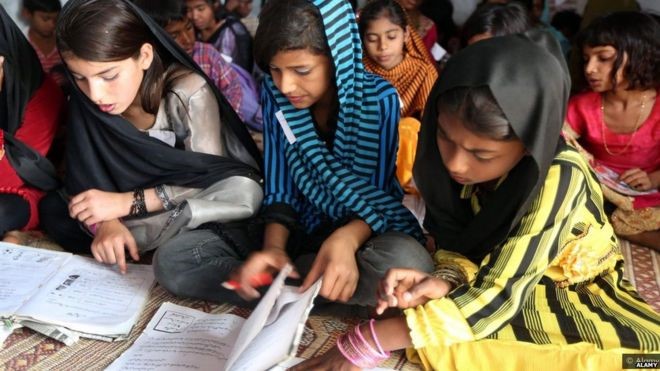How are children of Pakistan studying in the epidemic?
Corona virus has exposed the digital divide in Pakistan’s population. Will this lead to any meaningful debate on the future of technology in training?
12-year-old Khairunnisa Hussain logs in at the Zoom conference five days a week at 9 am. For four hours she works on math, science and French worksheets.
In an art assignment last month, he was sent an email to Damian Hearst’s painting which was to be copied. Every Tuesday, his PE teacher sends video links to yoga so that students can practice it.
More than three lakh schools of Pakistan have been closed since March due to Corona virus. The students of Hussain’s school in Lahore are lucky to have their classes on digital platforms. Millions of students of Pakistan are deprived of smartphones and internet.
Atiq Ali, who studied economics at the Institute of Business Administration, Karachi, moved to his native city of Turbat after the university was closed.
There is no wireless internet or 3G / 4G service. In a temperature of up to 50 degrees every day, he rides a bike for an hour and goes to his friend outside the city and downloads the lecture.
On phone interviews, Ali says, “It takes a lot of effort to get there, then there is no electricity, sometimes the internet is down.”
School education in pakistan
Out of Pakistan’s 7 crore children, about 2.28 crore children are out of school. The corona virus has exposed the technology’s inequality between them.
Umbreen Arif, Senior Education Advisor to the Government of Pakistan, believes that there is a risk of leaving behind more than 5 crore students studying in schools and universities.
Last month, hundreds of students demonstrated against the university’s decision to start online classes. Poor internet service is a big problem, especially in remote provinces like Balochistan, Khyber Pakhtunkhwa and Gilgit-Baltistan.
Home broadband outside of big cities of Pakistan is expensive. The penetration of the smartphone is 51 percent. According to Pakistan Telecom Authority, only 1 million children of school going age have access to digital devices and bandwidth.
Studying on television
Around 40 million children of Pakistan watch television. That is why the government has included TV in the distance education strategy and has created a separate channel called Teleschool.
It started on 13 April, two weeks after the school was closed. It is run on a government PTV home which is seen by 5.4 crore people. Teleschools are taught lessons from 1st to 12th standard which have been prepared by four Edtech companies of Pakistan.
At the end of May, a text messaging system with 2.5 million viewers was also added so that parents and students could connect with teachers. Pakistan’s Education Minister Shafqat Mahmood told the BBC that the government is working on opening a radio school so that remote areas can be reached.
Work is going on on e-learning portal with digital content and local area network system for the deprived areas. The Prime Minister has been proposed to introduce a “Student Relief Package” which includes giving cheap internet packages and measures to reduce fees from smartphones.
Arif says that the telescope was started with the help of $ 5 million from the World Bank. 20 million dollars have been taken from the Global Partnership for Education, dedicated to multilevel educational platforms in developing countries.
Discussions are on to get long-term help of $ 200 million from the World Bank to promote education in backward districts. But at the moment, the children of Pakistan are struggling.
Ten children, a smartphone
Till April, a student studying in 7th grade in a government school in Pakistan’s northwest district used to get her homework on her father’s smartphone. After the office opened, when his father was called on a job, the only Internet-enabled device in the house went 400 kilometers away. Now that student spends most of her time on correcting handwriting.
There are problems even in homes with smartphones. A woman who has been a teacher in a school in Lahore says that she has a smartphone but has 10 children in their shared family.
“All children study in different classes and have to teach different things. Sometimes we can take grandparents’ phones but most of the time they use my phone.”
A 15-year-old boy in Gujranwala says that he uses his brother’s phone to watch educational videos.
“But my brother is always on a tick-talk and gets irritated when I ask him for a call.”
When will the school open?
The closure of schools due to corona virus has increased the concern of parents and teachers. The schools were earlier scheduled to open on July 15, but now government officials expect the school to open from September 15 on the condition of the number of Corona patients. Meanwhile, online content is dying out.
Launching new learning apps and ensuring regular flow of online content is a big challenge. Educational technology (edtech) entrepreneurs are seeing the epidemic as an opportunity for expansion and investment in a long neglected sector.
Aaron Yasin, founder of the Talimabad app, says, “Mr. Rogers and children’s media giants got a lot of support from the government when they changed the landscape of education in a country like America.”
The Talimabad app uses cartoons and games to teach the national curriculum to primary school children. “There is hardly any educational media initiative in Pakistan that helps financially,” says Yasin.
Technology not a priority
Government officials believe that due to less number of devices and Internet connection, edtech has not been in their priority. The Muse sub is a learning app for primary school children. Its CEO Hassan bin Rizwan says that the reach of the smartphone is not an ideal, yet it is growing rapidly.
“10 million new connections added every month. Smartphones are growing faster than any other device.”
Yasin says, “Technology never stops. In the 90s, if someone says that we are going towards an electronic book that will have everything for study, work and entertainment, then no one trusts. If the smartphone reaches 90 percent Only after we start developing the industry, it will be too late. We will not be able to teach an entire generation of students. “
At present, the number of edtech is increasing due to the epidemic. Ever since schools have closed, the number of people joining the Talimabad app has increased by 660 percent. The Muse Lesson app has increased 200 percent.
Talha Munir, CEO of Knowledge Platform Pakistan, says that he has sold his EdTech product to 400 new schools. To sustain this pace, edtech experts advise the government to invest in private sector partnerships. He says that extensive testing of digital solutions should be allowed in about 2 lakh private schools in the country.
Future studies
Together with the country’s largest telecom network Jazz and EdTech company Knowledge Platform, the Government of Pakistan is running a pilot project in 75 high schools in Islamabad, but it has never been assessed. Jazz Chief Corporate and Enterprise Officer Ali Naseer says that this project has improved the marks of matriculation students by 30 percent.
Naseer also sees a ray of light in the Kovid-19 crisis. The virus has finally increased the government’s interest in the edtech sector. Says Naseer, “If the government takes the initiative to take it forward, I think EdTech will become a reality in two to three years.”
Technology is not a merge drug
Some experts recommend that the government first fix the current problems in the education sector. Such as quality of teachers, schools running in files and low level of education.
The Citizens Foundation is one of the largest network of cheap private schools in Pakistan. Its executive vice president Riyaz Kamalani says that the government needs to work from a long-term perspective.
“When we talk about the situation like corona virus, we should avoid getting caught in its trap. Technology is not the solution to all the problems.” He says that the quality of teachers and their role in education is the most important, which the government should focus on.
Talha Munir, CEO of Knowledge Platform Pakistan, advocates taking traditional education and technology together. “We feel that most students cannot learn by themselves without the involvement of teachers. We need to improve the quality of teachers and equip them with technology.”
Teach for Pakistan founder Khadija Shahpar Bakhtiar says that a complete digital solution is not the solution to Pakistan’s problems.
Study with mosque loudspeaker
Teach for Pakistan instructor Rida Rizvi, a suburban private school in Islamabad, helps students who do not have mobile phones in their families. She goes to the local mosques and declares on the loudspeaker so that such families take the material from the designated place.
High schools in Aminabad, Balochistan share video lessons on the WhatsApp group via a Wi-Fi connection. With the support of the provincial government and UNICEF, 35 thousand students are attached to the program ‘Mera Ghar Mera School’.
Bakhtiar of Teach for Pakistan says, “Some children have WhatsApp and some don’t even have a phone. They need different materials and solutions.”
“But the most important issue is to solve the current problems – invest on teachers so that studies are better. Temporal deviations from corona virus or technology are not right.” Tania Adras, the Prime Minister’s special advisor on digitization, says the government’s focus on technology is not a temporary solution.
“We have to think that education is not the problem of corona virus. For example – millions of children do not come to school.”
“I think the corona virus has given us a chance. Now it is up to us how we find a long-term solution to it.” Education Minister Mahmood says, “If God wished, we would come out quickly with the corona virus. But we do not want to stop. We feel that the use of technology in training is the way forward for Pakistan.”



